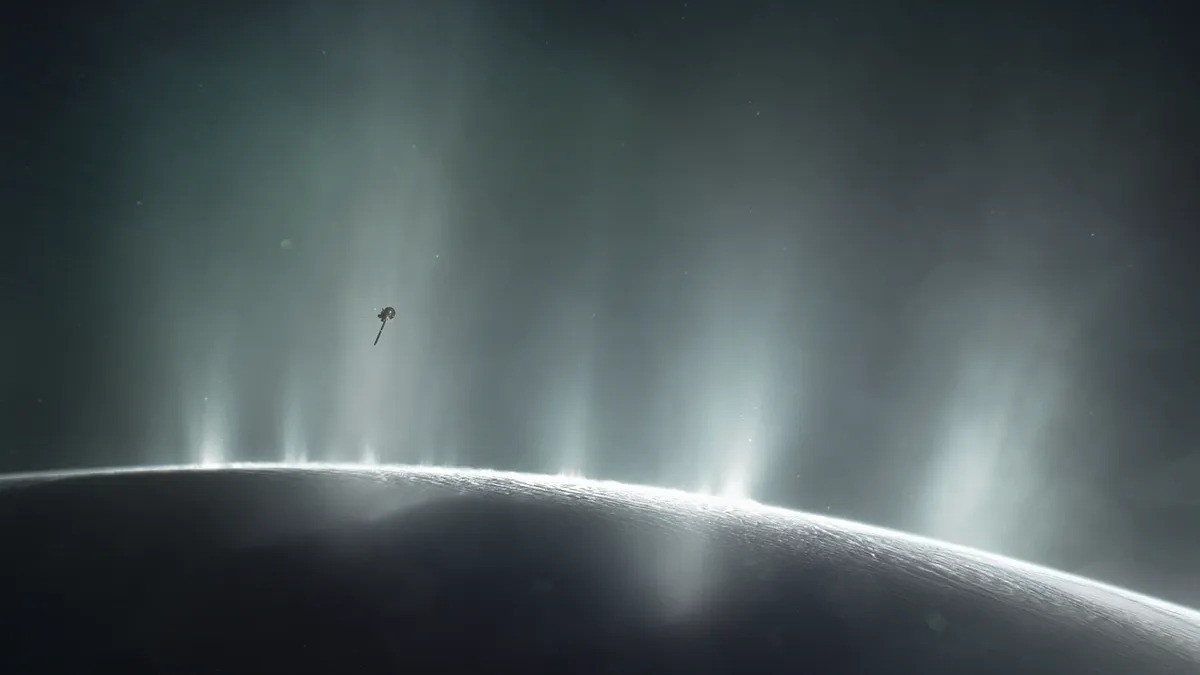Scientists already know that the ocean of Saturn’s moon Enceladus contains all the chemical elements necessary for the formation of living cells. Now they are interested in the question of whether they can be observed directly. Scientists have developed a special technique for this.

Geysers of the icy moon
Fabian Klenner, a scientist at the University of Washington, studies Saturn’s moon Enceladus. Earlier, he and his team had already been able to detect phosphorus and other molecules necessary for the existence of organic life in the emissions of geysers from it. In the new article, he considers a way to find bacteria there.
Saturn has 149 confirmed moons and Enceladus is one of the most interesting of them. Despite the fact that its diameter is only 504 km, it has an ocean of liquid water hidden under the ice. It is maintained in a liquid state by the heat in the core of this celestial body. There is no reason to doubt the correctness of these conclusions, because geysers beat directly into space from its surface.
From 2004 to 2017, the Cassini spacecraft, which was jointly created by NASA and ESA, operated in the Saturn system. It repeatedly plunged into the emissions of Enceladus geysers and was able to determine their chemical composition using a spectrograph placed on board.
It is thanks to the research of this vehicle that scientists know so much about Enceladus. For many years already, they have been analyzing the spectrograph data and finding signs of the presence of more and more new chemicals in them. First, they found sodium chloride, better known as table salt, and the year before last they proved the presence of phosphates, phosphorus-containing compounds that are an important component of living organisms on Earth.
How to prove the existence of life on Enceladus
Taking into account all the above data, Enceladus seems extremely similar to Earth at the time when life originated on it. Hot volcanic sources at its bottom can provide enough energy to maintain the existence of the biosphere, even if the sun’s rays never reach the depths of the ocean.
It remains only to find the living organisms themselves. According to Klenner, it is quite possible to do this already at the current level of technology development. For this, it is necessary to carefully examine the emissions of geysers again using a spectrometer. However, this time it should be a modern device that did not exist at the time when the Cassini mission was being prepared.
A method that can detect individual single solid grains in a liquid can help detect bacteria. This is exactly what Klenner and his colleagues used in their laboratory. They shot thin jets of water in the vacuum chamber, which instantly broke into individual droplets. Each of them theoretically contained only one bacteria.
Next, the researchers ionized this water with a laser and examined it with a mass spectrometer. They were able to prove that individual bacteria could be observed in this way if geysers ejected them from Enceladus.
Microorganisms of the species Sphingopyxis alaskensis are tiny. However, researchers have proven that mass spectrometry can find even smaller objects, such as individual molecules of amino acids and other components that make up proteins. This means that this method can tell a lot about life on Enceladus.
Future missions
If such an analyzer is placed on a spacecraft, it will be able to tell for sure whether there is life in the ocean of Enceladus or not. The mission to it is one of the highest priorities for both NASA and ESA. More space agencies are only interested in Uranus in the outer Solar System. Therefore, in the coming decades, scientists should find out for sure whether there are microorganisms on Enceladus and other moons of Saturn.
But regarding Jupiter’s moon Europa, we can find out even earlier. The launch of the Europa Clipper is scheduled for October 2024. It already carries a spectrometer on board, which is capable of detecting individual solid grains. Therefore, it is quite possible that it will discover the first irrefutable evidence of the existence of life beyond the Earth.
According to www.space.com
Follow us on Twitter to get the most interesting space news in time
https://twitter.com/ust_magazine


